
Myristica is a genus of trees in the family Myristicaceae. There are over 150 species, distributed in Asia and the western Pacific.

The Myristicaceae are a family of flowering plants native to Africa, Asia, Pacific islands, and the Americas and has been recognized by most taxonomists. It is sometimes called the "nutmeg family", after its most famous member, Myristica fragrans, the source of the spices nutmeg and mace. The best known genera are Myristica in Asia and Virola in the Neotropics.
Nutmeg is a spice, usually obtained from the plant Myristica fragrans. It may also refer to:

Monodora is a genus of plant in family Annonaceae. It contains approximately 15 species, distributed throughout tropical Africa.
Asteranthe asterias is a species of plant in the family Annonaceae. It is native to Kenya and Tanzania. Spencer Le Marchant Moore, the English botanist who first formally described the species using the basionym Uvaria asterias, did not explicitly explain the epithet, but was likely referencing the star-like appearance of its flower’s petals.
Hexalobus bussei is a species of plant in the family Annonaceae. It is native to Cameroon. Ludwig Diels, the German botanist who first formally described the species, named it after another German botanist, Walter Busse, who collected the sample that Diels examined.
Monodora carolinae is a species of plant in the family Annonaceae. It is native to Mozambique and Tanzania. Thomas Couvreur, the botanist who first formally described the species, named it after his wife Carolina.
Monodora crispata is a species of plant in the family Annonaceae. It is native to Cameroon, Equatorial Guinea, Gabon, Ghana, Guinea, Ivory Coast, Liberia, Nigeria, and Sierra Leone. Heinrich Gustav Adolf Engler, the German botanist who first formally described the species, named it after its curled petal margins.
Monodora globiflora is a species of plant in the family Annonaceae. It is native to Tanzania. Thomas Couvreur, the botanist who first formally described the species, named it after its inner petals that touch one another, but are not fused, and form a globe-shaped structure.
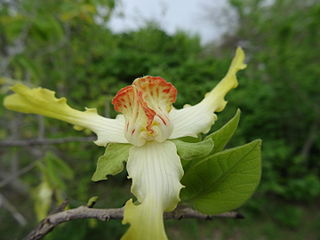
Monodora grandidieri is a species of plant in the family Annonaceae. It is native to Kenya, Malawi, Mozambique, Somalia, and Tanzania. Henri Ernest Baillon, the French botanist who first formally described the species, named it after the French naturalist and explorer Alfred Grandidier who collected the specimen Baillon examined. It has been reported to be used as a traditional medicine by the Giriama and Digo people of Kenya.
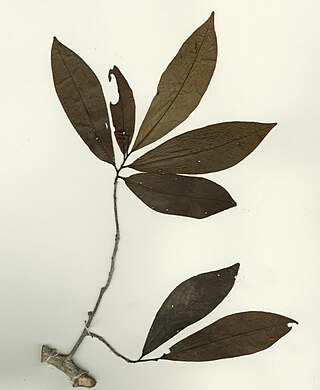
Monodora hastipetala is a species of plant in the family Annonaceae. It is native to Tanzania. Thomas Couvreur, the botanist who first formally described the species, named it after its spear shaped inner petals.
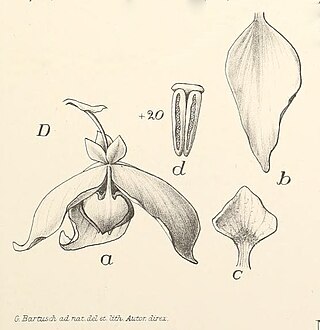
Monodora junodii is a species of plant in the family Annonaceae. It is native to Eswatini, Kenya, Malawi, Mozambique, South Africa, Tanzania, and Zimbabwe. Heinrich Gustav Adolf Engler and Ludwig Diels, the German botanists who first formally described the species, named it after Henri-Alexandre Junod, the Swiss missionary and scientist who collected the specimen that they examined.
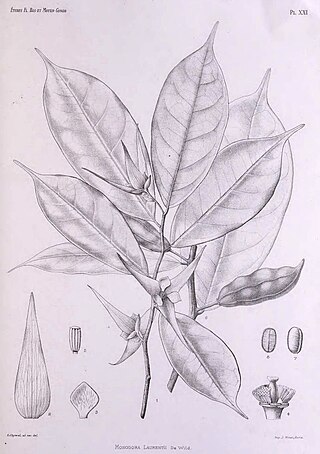
Monodora laurentii is a species of plant in the family Annonaceae. It is native to the Democratic Republic of the Congo, Gabon, and the Republic of the Congo. Émile De Wildeman, the Belgian botanist who first formally described the species, named it after Marcel Laurent, the Belgian botanist who collected many plant specimens in the regions along the Congo River.
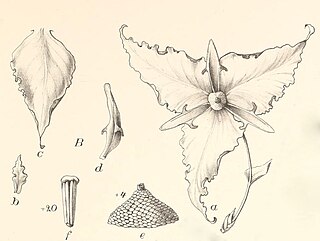
Monodora minor is a species of plant in the family Annonaceae. It is native to Mozambique and Tanzania. Heinrich Gustav Adolf Engler and Ludwig Diels, the German botanists who first formally described the species, do not explicitly explain the specific epithet but it is among the smaller members of the genus which includes species that reach heights of 30-40 meters.

Monodora stenopetala is a species of plant in the family Annonaceae. It is native to Malawi and Mozambique. Daniel Oliver, the English botanist who first formally described the species, named it after its narrow petals.

Monodora tenuifolia is a species of plant in the family Annonaceae. It is native to equatorial Africa. George Bentham, the English botanist who first formally described the species, named it after its slender leaves.
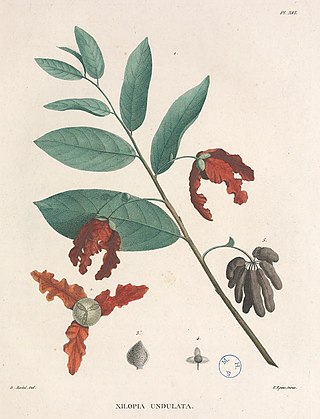
Monodora undulata is a species of plant in the family Annonaceae. It is native to Cameroon, the Central African Republic, Ghana, Guinea, Ivory Coast, Liberia, Nigeria and Sierra Leone. Palisot de Beauvois the botanist and entomologist who first formally described the species using the basionym Xylopia undulata, named it after the wavy margins of its petals.

Monodora angolensis is a species of plant in the family Annonaceae. It is native to Angola, Cameroon, Central African Republic, Democratic Republic of the Congo, Equatorial Guinea, Gabon, Ivory Coast, Nigeria, Republic of the Congo, Sudan, Tanzania, Uganda, Zambia and Zaire. Friedrich Welwitsch, the Austrian botanist who first formally described the species, named it after Angola where he found it growing near the town of Pungo-Andongo.

Myristica insipida, commonly known in Australia as Australian nutmeg, Queensland nutmeg or native nutmeg, is a small rainforest tree in the family Myristicaceae native to parts of Malesia, Papuasia and Australia. It is closely related to the commercially-important species of nutmeg, M. fragrans.

Uvariastrum pierreanum is a species of plant in the Annonaceae family. It is native to Cameroon, the Central African Republic, the Democratic Republic of the Congo, Equatorial Guinea, Gabon, Ghana, Guinea, the Ivory Coast, Liberia, Nigeria, Sierra Leone and the Republic of the Congo. Adolf Engler, the botanist who first formally described the species, named it after the French botanist Jean Baptiste Louis Pierre.















